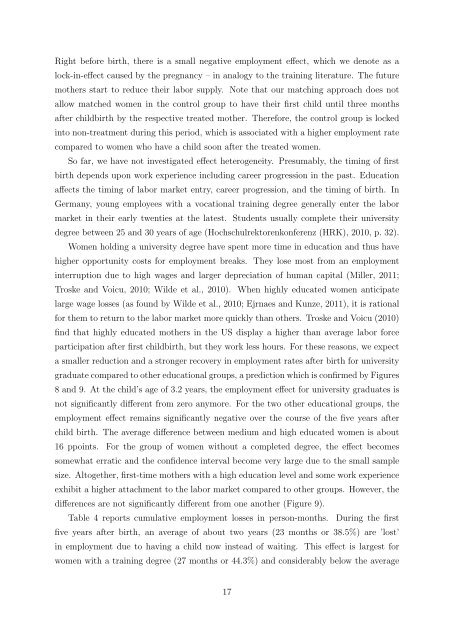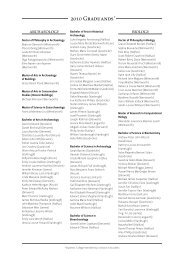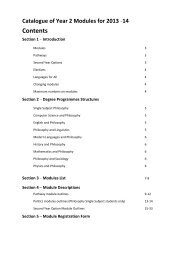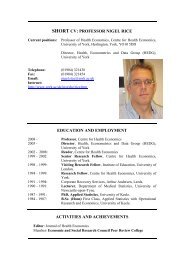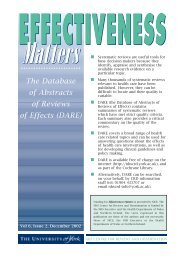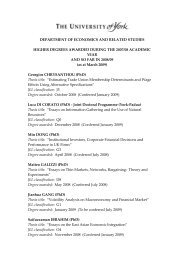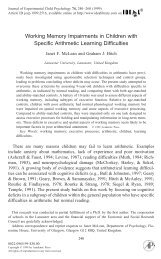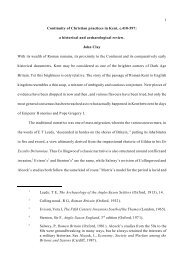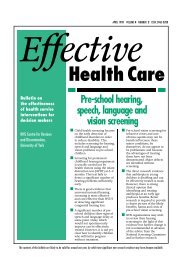Causal effects on employment after first birth - A ... - University of York
Causal effects on employment after first birth - A ... - University of York
Causal effects on employment after first birth - A ... - University of York
Create successful ePaper yourself
Turn your PDF publications into a flip-book with our unique Google optimized e-Paper software.
Right before <strong>birth</strong>, there is a small negative <strong>employment</strong> effect, which we denote as alock-in-effect caused by the pregnancy – in analogy to the training literature. The futuremothers start to reduce their labor supply. Note that our matching approach does notallow matched women in the c<strong>on</strong>trol group to have their <strong>first</strong> child until three m<strong>on</strong>ths<strong>after</strong> child<strong>birth</strong> by the respective treated mother. Therefore, the c<strong>on</strong>trol group is lockedinto n<strong>on</strong>-treatment during this period, which is associated with a higher <strong>employment</strong> ratecompared to women who have a child so<strong>on</strong> <strong>after</strong> the treated women.So far, we have not investigated effect heterogeneity. Presumably, the timing <strong>of</strong> <strong>first</strong><strong>birth</strong> depends up<strong>on</strong> work experience including career progressi<strong>on</strong> in the past. Educati<strong>on</strong>affects the timing <strong>of</strong> labor market entry, career progressi<strong>on</strong>, and the timing <strong>of</strong> <strong>birth</strong>. InGermany, young employees with a vocati<strong>on</strong>al training degree generally enter the labormarket in their early twenties at the latest. Students usually complete their universitydegree between 25 and 30 years <strong>of</strong> age (Hochschulrektorenk<strong>on</strong>ferenz (HRK), 2010, p. 32).Women holding a university degree have spent more time in educati<strong>on</strong> and thus havehigher opportunity costs for <strong>employment</strong> breaks. They lose most from an <strong>employment</strong>interrupti<strong>on</strong> due to high wages and larger depreciati<strong>on</strong> <strong>of</strong> human capital (Miller, 2011;Troske and Voicu, 2010; Wilde et al., 2010). When highly educated women anticipatelarge wage losses (as found by Wilde et al., 2010; Ejrnaes and Kunze, 2011), it is rati<strong>on</strong>alfor them to return to the labor market more quickly than others. Troske and Voicu (2010)find that highly educated mothers in the US display a higher than average labor forceparticipati<strong>on</strong> <strong>after</strong> <strong>first</strong> child<strong>birth</strong>, but they work less hours. For these reas<strong>on</strong>s, we expecta smaller reducti<strong>on</strong> and a str<strong>on</strong>ger recovery in <strong>employment</strong> rates <strong>after</strong> <strong>birth</strong> for universitygraduate compared to other educati<strong>on</strong>al groups, a predicti<strong>on</strong> which is c<strong>on</strong>firmed by Figures8 and 9. At the child’s age <strong>of</strong> 3.2 years, the <strong>employment</strong> effect for university graduates isnot significantly different from zero anymore. For the two other educati<strong>on</strong>al groups, the<strong>employment</strong> effect remains significantly negative over the course <strong>of</strong> the five years <strong>after</strong>child <strong>birth</strong>. The average difference between medium and high educated women is about16 ppoints. For the group <strong>of</strong> women without a completed degree, the effect becomessomewhat erratic and the c<strong>on</strong>fidence interval become very large due to the small samplesize. Altogether, <strong>first</strong>-time mothers with a high educati<strong>on</strong> level and some work experienceexhibit a higher attachment to the labor market compared to other groups. However, thedifferences are not significantly different from <strong>on</strong>e another (Figure 9).Table 4 reports cumulative <strong>employment</strong> losses in pers<strong>on</strong>-m<strong>on</strong>ths. During the <strong>first</strong>five years <strong>after</strong> <strong>birth</strong>, an average <strong>of</strong> about two years (23 m<strong>on</strong>ths or 38.5%) are ’lost’in <strong>employment</strong> due to having a child now instead <strong>of</strong> waiting. This effect is largest forwomen with a training degree (27 m<strong>on</strong>ths or 44.3%) and c<strong>on</strong>siderably below the average17


